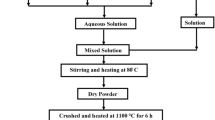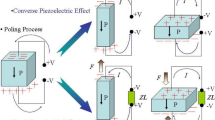Abstract
Lead oxide based ferroelectrics, represented by lead zirconate titanate (Pb(Zr, Ti)O3) or PZT) are the most widely used materials for piezoelectric actuators, sensors and transducers due to their excellent piezoelectric properties. Considering lead toxicity, there is interest in developing piezoelectric materials that are biocompatible and environmentally friendlier. The low density of non-lead based materials can also be an advantage in transducers for underwater and medical imaging due to expected lower acoustical impedance. Another impetus for seeking alternative to lead based compositions is the need for piezoelectric materials for operation at high temperatures. Several classes of materials are now being reconsidered as potentially attractive alternatives to PZT for special applications. The potassium niobate family, KNbO3, exhibits low dielectric constants, large thickness coupling coefficient along certain non-polar directions, and low density, all of which have advantages for high frequency transducer applications. Several compositions belonging to bismuth titanate family, Bi4Ti3O12, such as SrTi4Bi4O15, are promising candidates for high temperature applications. Lead free materials alone (eg. (Na0.5Bi0.5)TiO3) or in solution with PT (BiScO3 – PbTiO3) are also potentially interesting as they combine high piezoelectric activity and, in some cases, relatively high T c . For these families of piezoelectric materials, the processing and piezoelectric response under different conditions of pressure, frequency, and temperature are presently much less understood than for the classical lead containing systems. In this presentation we review and discuss piezoelectric properties of selected lead free compositions (principally for members of the potassium niobate family and bismuth titanate layered compounds) in relation to structural and microstructural features as well as extrinsic contributions (domain walls displacement, conductivity) to their electromechanical properties. It is shown that it is possible to obtain remarkably stable piezoelectric response in some compositions, while others exhibit strong dependence of piezoelectric properties on driving field and frequency. Origins of these different behaviours are discussed.
Similar content being viewed by others
References
B. Jaffe, W.R. Cook, and H. Jaffe, Piezoelectric Ceramics (Academic, New York, 1971).
J.W. Waanders, Piezoelectric Ceramics-Properties and Applications (Philips Components, Eindhoven, 1991).
A. Zomorrodian, N.J. Wu S. Wilczac C. Colbert A. Ignatiev, in La-doped PbZrTiO3(PLZT) Thin Film Optical Detector (TOD) for Retinal Implantation—A “Bionic” Eye, 2002.
M. Kosec, private communication.
D. Damjanovic, Current Opinion in Solid State & Materials Science, 3, 469 (1998).
R.C. Turner, P.A. Fuierer, R.E. Nenwham, and T.R. Shrout, Applied Acoustics, 41, 299 (1994).
G. Shirane, H. Danner, A. Pavlovic, and R. Pepinsky, Phys. Rev., 93, 672 (1954).
K. Nakamura, and M. Oshiki, Appl. Phys. Lett., 71, 3202 (1997).
K. Nakamura and Y. Kawamura, in Proceedings of the 1999 IEEE Ultrasonics Symposium (1999), p. 1013.
K. Nakamura, and Y. Kawamura, IEEE Transactions UFFC, 47, 750 (2000).
K. Nakamura, T. Tokiwa, and Y. Kawamura, Journal of Applied Physics, 91, 9272 (2002).
D. Damjanovic, F. Brem, and N. Setter, Appl. Phys. Lett., 80, 652 (2002).
E. Wiesendanger, Ferroelectrics, 6, 263 (1974).
F. Jona and G. Shirane, Ferroelectric Crystals, (Pergamon, New York, 1962).
M. Kosec and D. Kolar, Mat. Res. Bull., 10, 335 (1975).
A. Reisman and F. Holtzberg, J. Am. Chem. Soc., 77, 2115 (1955).
R.E. Jaeger and L. Egerton, J. Am. Ceram. Soc., 45, 209 (1962).
G.H. Heartling, J. Am. Ceram. Soc., 50, 329 (1967).
N.M. Kari, T.A. Ritter, S.E. Park, T.R. Shrout, K.K. Shung, in Investigation of Potassium Niobate as an Ultrasonic Transducer Material (Puertorico, 2000).
B. Aurivillus, Ark. Kemi, 1, 499 (1949).
R.E. Newnham, R.W. Wolfe, and J.F. Dorrian, Mater. Res. Bull., 6, 1029 (1971).
T. Takenaka, K. Maruyama, and K. Sakata, Jpn. J. Appl. Phys., 30, 2236 (1991).
T. Takenaka and K. Sakata, Jpn. J. Appl. Phys., 19, (1980).
T. Takenaka and K. Sakata, Ferroelectrics, 38, 769 (1981).
T. Takenaka and K. Sakata, Jpn. J. Appl. Phys., 20, 161 (1981).
T. Takenaka and K. Sakata, Jpn. J. Appl. Phys., 20, 189 (1981).
T. Takenaka, K. Sakata, and K. Toda, Japan. J. Appl. Phys., 24, 730 (1985).
T. Takenaka, K. Shoji, K. Sakata, in 20th Japan Congress on Materials Research (Kyoto, 1976).
T. Takenaka, K. Shoji H. Takai, K. Sakata, in Ferroelectric and Dielectric Properties of Press Forged Bi4Ti3 O12Ceramics (Tokyo, 1975).
E.C. Subbarao, J. Phys. Chem. Solids., 23, 665 (1962).
V.M. Gurevich, in Electric Conductivity of Ferroelectrics, edited by T. f. R. b. t. I. P. f. S. Translations (Jerusalem, 1971).
S.S. Lopatin, T.G. Lupeiko, T.L. Vasil’tsva, N.I. Basenko, and I.M. Berlizev, Inorg. Mater., 24, 1328 (1988).
H.S. Shulman, Ph. D. Thesis, Swiss Federal Institute of Technology - EPFL, 1997.
H.S. Shulman, M. Testorf, D. Damjanovic, and N. Setter, J. Am. Ceram. Soc., 79, 3124 (1996).
S.H. Hong, J.A. Horn, S.T.-M. Kinstry, and G.L. Messing, Journal of Materials Science Letters, 19, 1661 (2000).
L. Sagalowicz, F. Chu, P. Duran Martin, and D. Damjanovic, J. Appl. Phys., 88, 7258 (2000).
F. Chu, D. Damjanovic, N. Setter, in An Investigation of Dielectric and Piezoelectric Properties of Bi4Ti3 O12 + Bi3TiNbO9 Ceramics, 1995 (Gruppo Editoriale Feanza Editrice, Riccione), p. 197.
F. Chu, D. Damjanovic, O. Steiner, and N. Setter, J. Am. Ceram. Soc., 78, 3142 (1995).
I.M. Reaney and D. Damjanovic, J. Appl. Phys., 80, 4223 (1996).
S.E. Cummins and L.E. Cross, J. Appl. Phys., 39, 2268 (1968).
D. Damjanovic, M. Demartin Maeder, C. Voisard, and N. Setter, J. Appl. Phys. (2001) (submitted).
T. Takeuchi, T. Tani, and Y. Saito, Japanese Journal of Applied Physics Part 1—Regular Papers Short Notes and Review Papers, 38, 5553 (1999).
T. Takeuchi, T. Tani, and Y. Saito, Japanese Journal of Applied Physics Part 1—Regular Papers Short Notes and Review Papers, 39, 5577 (2000).
Author information
Authors and Affiliations
Rights and permissions
About this article
Cite this article
Maeder, M.D., Damjanovic, D. & Setter, N. Lead Free Piezoelectric Materials. J Electroceram 13, 385–392 (2004). https://doi.org/10.1007/s10832-004-5130-y
Received:
Revised:
Accepted:
Issue Date:
DOI: https://doi.org/10.1007/s10832-004-5130-y




